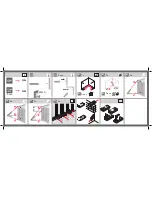
Tel: 886.909 602 109 Email: [email protected]
7
Chapter 2 Working Principle
The S3302 series spectrum analyzer consists of 4 mutually independent function modules with standard
interfaces, namely microwave/millimeter-wave frequency conversion module, frequency synthesis module, IF
signal processing module, and data processing, display and control module. Such a design facilitates
maintenance of the main unit and replacement of the parts, and also significantly reduces the re-debugging
workload of the main unit after the module replacement. The hardware scheme of the main unit is as shown in
Fig.1.
Second
-stage
mixer
Filter
Program
mable
attenuator
Millimeter-wave
downconverter
Filter
Filter
First local
oscillator
VCO ring of
the second
local oscillator
Filter
Four-wave
mixer
A D
Microprocessor
FPGA
Keyboard
LCD
Third
-stage
mixer
Second
-stage
mixer
Third
-stage
mixer
Second
-stage
mixer
Reference ring
Power supply
management
Microwave/millimeter-
Low-pass filter
IF amplifier
Input
Switch filter
IF amplifier
Multiplying filter
Switch filter
IF amplifier
Frequency synthesis
module
IF amplifier
Second and third
local oscillators
Decimal ring
Sampling ring
Fourth local
oscillator
Data processing, display and
control module
Fig.1 Diagram of Hardware of the Main Unit
2.1 Microwave/Millimeter-Wave Frequency Conversion Module
It is mainly used for receiving and down-conversion of the input signals of the microwave and millimeter-wave
frequency band. The input signals will enter the frequency conversion module through the blocking module
and 50 dB programmable step attenuator. The RF signals of 9kHz - 20 GHz and broadband local oscillator
signals of 6 GHz - 12 GHz (or its second harmonic) are mixed to produce three second IF signals, namely
6,540.25 MHz of the first band (RF frequency is 9 kHz - 5.35 GHz), 1,740.25 MHz of the second band (RF
frequency is 5.35 GHz - 13 GHz) and 3,340.25 MHz of third band (RF frequency is 13 GHz - 20 GHz), and
then output 140.25MHz IF signal to the IF channel plate through down-conversion of the third-stage mixer.
The signals above 20 GHz frequency band are mixed with the first LO signal after the preamplifier and
subsection switching filter to produce first IF signal (5 GHz - 16.5 GHz).The first IF signal and RF signals of
9kHz - 20 GHz are switched into the second-stage mixer after switching by a single-pole double-throw switch,









































